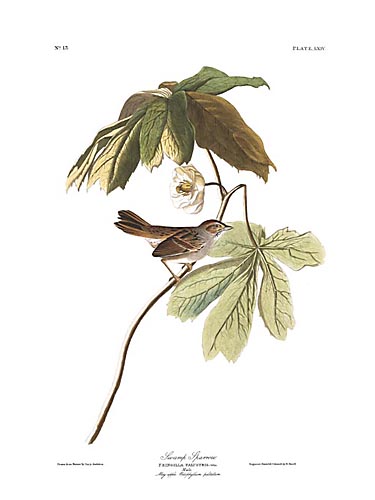|
Havell Name
Swamp Sparrow Common Name Swamp Sparrow Havell Plate No. 064 Paper Size 39" x 28" Image Size 16" x 11" Price $ 600 |
||||
|
Ornithological Biography The shores and such flat sand-bars as are overgrown with grasses and rank weeds, along the Mississippi, from its mouth to a great height, as well as the swamps that occur in the woods, within a short distance from the margins of that river, are the resorts of the Swamp Sparrow, during autumn and winter. Although these birds do not congregate in flocks, their numbers are immense. They form the principal food of the many Sparrow Hawks, Pigeon Hawks, and Hen-harriers, which follow them as well as several ether species, on their return from the Middle Districts, where they go towards spring, for the purpose of breeding. In those districts they continue to prefer low swampy places, damp meadows, and the margins of creeks and rivers.
It is a timid species; destitute of song, and merely uttering a single cheep, which is now and then heard during the day, but more frequently towards evening. They skulk along the weeds with activity, and feed principally upon the seeds of grasses, with a few insects, sometimes wading in shallow water. When wounded and forced to fall in the stream, they swim off to the nearest tuft of grass and hide in it. Their flight is short, low, and assisted by strong jerking motions of the body and tail, accompanied by a rustling of the wings. They alight by dropping suddenly amongst the weeds, seldom making towards a high tree. They are rarely if ever met with in dry woodlands. Their nest is placed on the ground, at the foot of a large bunch of tall grass. It is composed of dry weeds and finer fibres of the same, and is sometimes partially covered over. The eggs are four or five, of a dull white, speckled with reddish. They raise two, sometimes three, broods in a season. I found these birds abundantly dispersed in the swamps of Cayuga Lake, and those bordering the Illinois river, during summer, and far up the Arkansas river in the winter months. Their flesh is sedgy, which perhaps forms no objection to some people against its use. They become fat and tender, when the weeds have produced an abundance of seeds. Their note differs from that of all other species of Sparrow, being harsher in its tone. The young follow the parents on the ground, skulking among the grass for nearly a week before they are able to fly. This bird is abundant, in company with the Tree Sparrow, during winter, about Boston. It is not mentioned by Dr. RICHARDSON as being an inhabitant of the Fur Countries, although I found it plentiful in Labrador and Newfoundland, as well as in all the districts suited to its habits between these countries and the Texas. Mr. TOWNSEND informs me that it is found on the Missouri, but was not observed beyond the head-waters of that river. From Texas to North Carolina in winter. Spreads in spring and summer to the Missouri westward, and to Labrador eastward. Abundant. |
|||||
|
|
|||||


| Home | Gallery | Audubon Biography | About Edition | Testimonials | Authorized Dealers | Links | Contact Us |

© Copyright 2007-2025 Zebra Publishing, LLC. | All Rights Reserved Terms of Use
Powered by Fusedog Media Group
